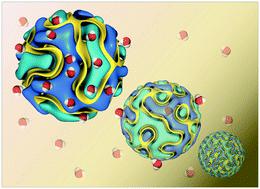当前位置:
X-MOL 学术
›
Mol. Syst. Des. Eng.
›
论文详情
Our official English website, www.x-mol.net, welcomes your feedback! (Note: you will need to create a separate account there.)
Molecular engineering of super-swollen inverse bicontinuous cubic and sponge lipid phases for biomedical applications
Molecular Systems Design & Engineering ( IF 3.6 ) Pub Date : 2020-08-14 , DOI: 10.1039/d0me00076k Jiali Zhai 1, 2, 3, 4, 5 , Sampa Sarkar 1, 2, 3, 4, 5 , Charlotte E. Conn 1, 2, 3, 4, 5 , Calum J. Drummond 1, 2, 3, 4, 5
Molecular Systems Design & Engineering ( IF 3.6 ) Pub Date : 2020-08-14 , DOI: 10.1039/d0me00076k Jiali Zhai 1, 2, 3, 4, 5 , Sampa Sarkar 1, 2, 3, 4, 5 , Charlotte E. Conn 1, 2, 3, 4, 5 , Calum J. Drummond 1, 2, 3, 4, 5
Affiliation

|
The remarkable range of lyotropic liquid crystalline mesophases formed by lipid self-assembly in aqueous conditions has generated significant research interest, particularly due to their potential applications in drug delivery, in meso crystallisation, imaging, biocatalysis, and enzymatic reaction control. Among these mesophases, the inverse bicontinuous cubic mesophase, in particular, exhibits an intriguing structure with a continuous tortuous lipid membrane subdividing three-dimensional space into two interpenetrating water channels. The sponge phase is often called the melted cubic phase, as its structure is also characterised by the existence of two water channels separated by a continuous lipid bilayer but the surface is random and sponge-like. Distinct lipid membrane and aqueous regions within the lipidic cubic and sponge structure can be exploited to encapsulate hydrophobic and hydrophilic entities, respectively. A key advantage is that the cubic or the sponge structure can be fine-tuned via compositional or environmental mechanisms towards the control of diffusion and release rates for cargo molecules, as well as crystal growth during in meso crystallisation. However, a major drawback of most conventional laboratory synthesised lipidic cubic and sponge structures is the small size of the aqueous channels (typical dimensions of 3–5 nm) which limits the accommodation of large biomolecules such as soluble globular proteins, membrane proteins with large extracellular domains, and nucleic acids. Over the past two decades, interest has grown in designing super-swollen water channels that considerably exceed the normal dimension within lipidic cubic or sponge mesophases. Several swelling mechanisms have been developed, including those based on electrostatic swelling, headgroup hydration, and the variation of external conditions. To date, the water channels of some lipidic cubic and sponge mesophases have been increased to over 40 nm in diameter rendering such materials capable of encapsulating much larger biomolecules than had previously been achieved (e.g. β-galactosidase with a measured hydrodynamic radius of 11.8 nm). In this mini-review article, we summarise the current literature on highly swollen lipidic cubic and sponge mesophases, discuss the molecular system approaches used to achieve swelling, present first order design principles for guidance, and provide application examples in drug delivery and in meso protein crystallisation.
中文翻译:

用于生物医学应用的超溶胀的反相双连续立方和海绵脂质相的分子工程
由脂质在水性条件下自组装形成的溶致液晶中间相的范围广泛,引起了广泛的研究兴趣,特别是由于它们在药物递送方面具有潜在的应用前景。结晶,成像,生物催化和酶促反应控制。在这些中间相中,逆双连续立方中间相尤其表现出有趣的结构,其连续的曲折脂质膜将三维空间细分为两个互穿的水通道。海绵相通常被称为熔化的立方相,因为其结构的特征还在于存在两个被连续的脂质双层隔开的水通道,但表面是无规的且呈海绵状。可以利用脂质立方和海绵结构内不同的脂质膜和水区域分别包裹疏水和亲水实体。一个关键的优点是立方体或海绵状结构可以被微调经由组成或环境机制,以控制货物分子的扩散和释放速率以及内消旋过程中的晶体生长结晶。但是,大多数常规实验室合成脂质立方和海绵结构的主要缺点是水通道的尺寸较小(典型尺寸为3-5 nm),这限制了大生物分子(如可溶性球状蛋白,具有大细胞外膜蛋白的膜蛋白)的容纳域和核酸。在过去的二十年中,人们对设计超溶胀的水通道的兴趣日益增加,这些通道大大超出了脂质立方或海绵中间相的正常尺寸。已经开发了几种溶胀机制,包括基于静电溶胀,头基水合和外部条件变化的溶胀机制。至今,例如,测得的流体动力学半径为11.8 nm的β-半乳糖苷酶)。在这篇小型综述文章中,我们总结了有关高度溶胀的脂质立方相和海绵中间相的最新文献,讨论了用于实现溶胀的分子系统方法,提出了指导的一级设计原理,并提供了药物递送和内消旋蛋白的应用实例结晶。
更新日期:2020-09-28
中文翻译:

用于生物医学应用的超溶胀的反相双连续立方和海绵脂质相的分子工程
由脂质在水性条件下自组装形成的溶致液晶中间相的范围广泛,引起了广泛的研究兴趣,特别是由于它们在药物递送方面具有潜在的应用前景。结晶,成像,生物催化和酶促反应控制。在这些中间相中,逆双连续立方中间相尤其表现出有趣的结构,其连续的曲折脂质膜将三维空间细分为两个互穿的水通道。海绵相通常被称为熔化的立方相,因为其结构的特征还在于存在两个被连续的脂质双层隔开的水通道,但表面是无规的且呈海绵状。可以利用脂质立方和海绵结构内不同的脂质膜和水区域分别包裹疏水和亲水实体。一个关键的优点是立方体或海绵状结构可以被微调经由组成或环境机制,以控制货物分子的扩散和释放速率以及内消旋过程中的晶体生长结晶。但是,大多数常规实验室合成脂质立方和海绵结构的主要缺点是水通道的尺寸较小(典型尺寸为3-5 nm),这限制了大生物分子(如可溶性球状蛋白,具有大细胞外膜蛋白的膜蛋白)的容纳域和核酸。在过去的二十年中,人们对设计超溶胀的水通道的兴趣日益增加,这些通道大大超出了脂质立方或海绵中间相的正常尺寸。已经开发了几种溶胀机制,包括基于静电溶胀,头基水合和外部条件变化的溶胀机制。至今,例如,测得的流体动力学半径为11.8 nm的β-半乳糖苷酶)。在这篇小型综述文章中,我们总结了有关高度溶胀的脂质立方相和海绵中间相的最新文献,讨论了用于实现溶胀的分子系统方法,提出了指导的一级设计原理,并提供了药物递送和内消旋蛋白的应用实例结晶。



























 京公网安备 11010802027423号
京公网安备 11010802027423号